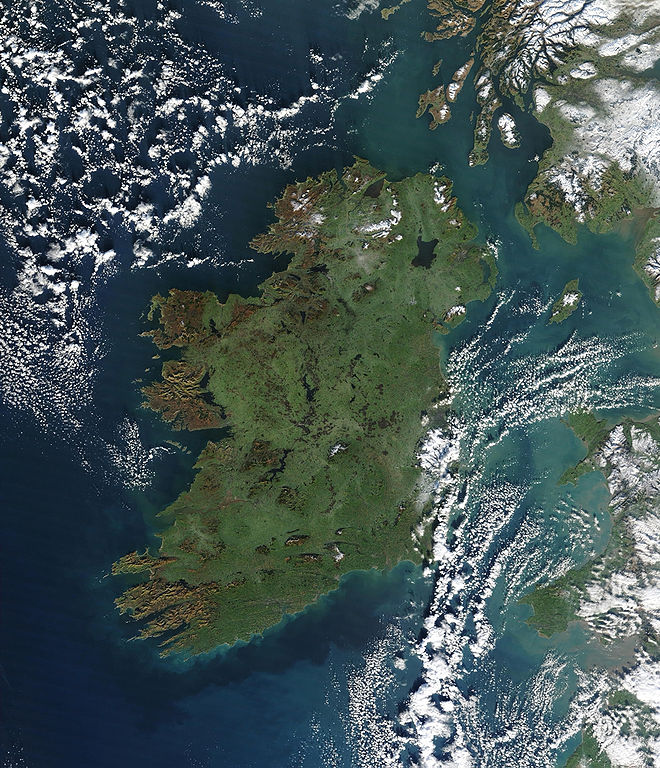Ireland has only 0.064% of the world’s population. Yet it has international influence that far exceeds its size. Today, St Patrick’s celebrations involve over 150,000 people in New York City alone,[1] and around 34 million Americans consider themselves to have Irish heritage, over 7 times the population of Ireland itself.[2]
St Patrick’s early adulthood was one of greatly limited freedom. He was born in Britain around 385 AD. He was kidnapped, according to an early Christian document entitled the Confession of St Patrick,[3] by Irish Raiders at the age of 16 and sold into slavery. After 6 years working as a Shepherd, the Confession tells of him hearing a voice from God calling him to a ship that was waiting to take him back to Britain. Back then, the ferry crossing took 3 days. Following the crossing he travelled for 28 days ‘through uninhabited country. As if his first ordeal hadn’t been enough, he was captured in Britain for a further 60 days.[4]
It was in Ireland, however, that St Patrick experienced a newfound faith in God. It was, likewise, a call from God that led him back to Ireland, even though it involved leaving family and returning to the land which had initially held him in captivity for so many years. His life was characterised by great humility, calling himself an ‘obviously unlearned sinner’, and the Confession speaks extremely honestly about his own struggles with self-doubt and regret.[5]
 |
| “If you’re Irish, it doesn’t matter where you go – you’ll find family.” – Victoria Smurfit |
Patrick was passionate about standing against and banishing what we would today call human rights abuses. In his Confession, he expresses heartfelt concern for those in slavery in Ireland, saying they ‘suffer the most’ and ‘endure terrors and constant threats’.[6] Unlike many figures in authority at the time, he did not stand back and accept grave injustice.
Patrick’s other surviving work, a letter ‘To the Soldiers of Coroticus’, is poignant. The Brittonic warrior Coroticus and his soldiers had attacked, killed and enslaved many Christians in Ireland. He doesn’t mince his words of accusation, saying that their ‘hands drip with the blood of the innocent Christians you have murdered’ and that they ‘bathe in the blood of God’s own children — the Irish…’. [7] He had deep words of affection for the people to whom he ministered in Ireland, mourning for them as his ‘beautiful, beloved family and children’.[8] As he had left his natural family behind, these people had become sisters and brothers, mothers, sons and daughters to him. He looked to a future when family and society would know no social, economic or national barriers.
Yet even though he had been hurt, his letter ends with a plea in hope that the soldiers involved in the murders would ‘all find the peace of the Father, Son, and Holy Spirit’.[9] Unlike many, he did not seek revenge – he did not believe causing pain would solve his own pain. He fought peacefully for the freedom and liberation of an oppressed people, believing all were loved and cared for by God.
One wonders what St Patrick’s approach would have been if he had encountered people with leprosy. It is these people who often suffer the most exclusion from society, effectively a slavery to the disease that offers them no respite or freedom to live in peace with their family. It seems that, though he had little knowledge of the medicinal science we have today, he would have likewise affirmed their value and worth and fought for their freedom. May we follow his example this St Patrick’s day by fighting for the rights of those marginalised and excluded from society. In this way, let the whole world be bathed with green!
Add your voice in our battle to bring people affected by leprosy the recognition, compassion and freedom they deserve:
Sources:
[1] http://www.telegraph.co.uk/travel/destinations/europe/ireland/10683105/St-Patricks-Day-2014-Celebrations-and-parades-around-the-world.html
[2] http://www.telegraph.co.uk/news/worldnews/europe/ireland/5005127/St-Patricks-Day-Top-10-facts.html
[3] http://www.ccel.org/ccel/patrick/confession.ii.html
[4] http://www.ccel.org/ccel/patrick/confession.v.html
[5] http://www.ccel.org/ccel/patrick/confession.xi.html
[6] http://www.ccel.org/ccel/patrick/confession.x.html
[7] http://courses.ttu.edu/gforsyth/st_patrick001.pdf, pp. 170-171.
[8] http://courses.ttu.edu/gforsyth/st_patrick001.pdf, p. 173.
[9] http://courses.ttu.edu/gforsyth/st_patrick001.pdf, p. 175.


Comments:
Amazing issues here. I am very satisfied to look your article.
Thanks a lot and I am taking a look ahead to touch you.
Will you kindly drop me a e-mail?
We’re a gaggle of volunteers and starting a brand
new scheme in our community. Your site provided us with useful
info to work on. You have performed a formidable task and
our whole group will probably be thankful to you.
Thanks very nice blog!
I wanted to thank you for this very good read!! I certainly enjoyed every little bit of it.
I have got you bookmarked to look at new things you post…